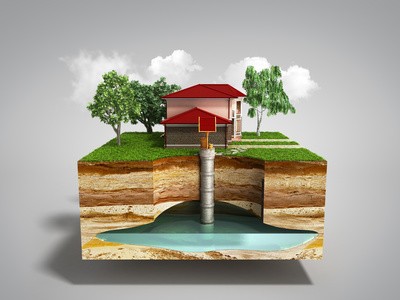The Components of a Modern Water Well System
 Water wells have been around for a long time. Like most things that have stood the test of time, improvements have been made along the way. Advances in technology have also affected how we build and use water wells today.
Water wells have been around for a long time. Like most things that have stood the test of time, improvements have been made along the way. Advances in technology have also affected how we build and use water wells today.
Today’s water well system is made using the latest equipment and tools. A good analogy would be an iceberg – you can see the tip, but there’s a lot more of it underneath.
Let’s take look at the parts of a modern water well system and how they all work together.
Well Screen
After the drilling has been finished and the aquifer has been accessed, there needs to be a way to keep the water free of excess sediment. That’s because the water pump can be damaged if large particles go through it. The well screen is made just for this purpose.
There are many different types of well screens, but they all do the same job: to filter water from the aquifer into the well.
Water Pump
Once the water has been filtered into the well, it’s the pump’s job to move water through the plumbing of your property. A water pump draws in the water inside the well casing and delivers it through your water pipes.
There are two common types of pumps. One is called a jet pump and the other a submersible pump. A jet pump is mounted above ground while a submersible pump is installed underground. Though they use different principles, their purpose is to move water from under the ground and into your home’s plumbing. You can say that they’re the heart of the system.
Casing
The parts we’ve discussed so far aren’t just stuck underground without any protection. They’re located inside the casing of the well. It’s shaped like a tube and is used to keep the water and equipment easily accessible. Aside from housing the equipment, it also serves as a barrier to keep underground contaminants from entering the well and mixing with the water.
Today, the casing is usually made of PVC. Though less common, they can also be made from steel, fiberglass, or even concrete.
Wellhead
Topping off the system is the wellhead. This is likely the only part you’ll ever see above ground. It allows for easy access to the parts inside the casing in the event that anything needs to be serviced. The wellhead also prevents any contaminants from entering the well from above the ground such as debris, insects, and small animals.
The opening of the wellhead is usually placed at least 6 to 8 inches above the ground. In locations that are known to be susceptible to flooding, it should be even higher to prevent overflowing water from contaminating the well.
I Want To Know More About Water Wells and Your Well Drilling Services!
To know more about water wells and how they can benefit you, get in touch with Ries Well Drilling. We install, maintain, and service water wells and their related equipment like constant pressure systems so homeowners can enjoy their own personal water source and say goodbye to monthly water bills. Call us today!
We provide Water Well Drilling Services in the following Michigan Counties:
